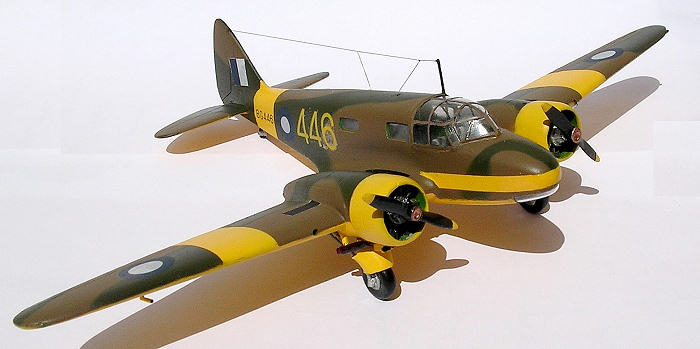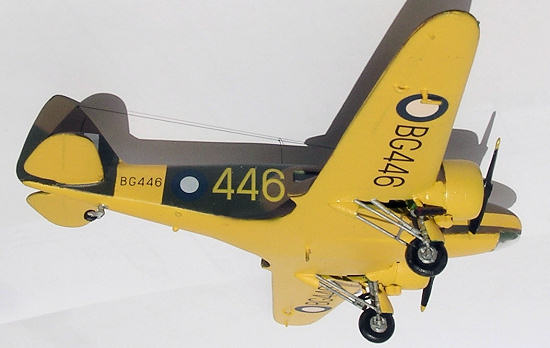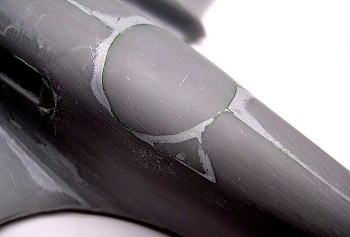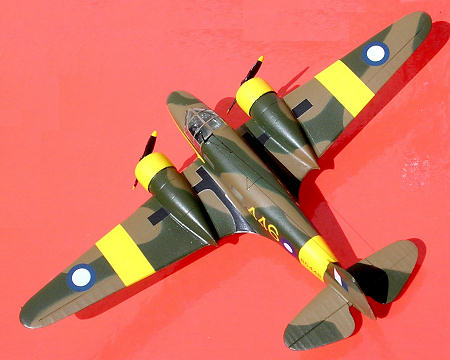
| KIT: | Pavla 1/72 Airspeed Oxford |
| KIT #: | ? |
| PRICE: | ? |
| DECALS: | ? |
| REVIEWER: | Carmel J. Attard |
| NOTES: | Short run kit |

| HISTORY |
The Oxford is a military development of the 1934 Airspeed Envoy feeder liner. It was the first twin-engined monoplane advance trainer to enter RAF service. It first went into service in January 1939 and at the outbreak of war there were nearly 400 of the type in service.
The
Oxford was a low wing monoplane of full wooden structure with a semi monocoque
fuselage, linen covered control surfaces
 and hydraulically retracted
undercarriage. The aircraft was powered by the Armstrong–Siddeley Cheetah IX
radial engine with the Fairey Reed 2-bladed metal propellers. Later, the Oxford
Mk 1s and with three crew members were powered by Cheetah X engine and wooden
propellers. An Armstrong Whitworth gun turret was mounted on the fuselage. This
had a 7.69 mm Lewis machine gun and a bombsight in a glazed nose. These were
used as trainers for bomb aimers and gunners. The Oxford Mk2 version had double
controls and carried no gun turret and were used to train pilots, navigators and
wireless operators.
and hydraulically retracted
undercarriage. The aircraft was powered by the Armstrong–Siddeley Cheetah IX
radial engine with the Fairey Reed 2-bladed metal propellers. Later, the Oxford
Mk 1s and with three crew members were powered by Cheetah X engine and wooden
propellers. An Armstrong Whitworth gun turret was mounted on the fuselage. This
had a 7.69 mm Lewis machine gun and a bombsight in a glazed nose. These were
used as trainers for bomb aimers and gunners. The Oxford Mk2 version had double
controls and carried no gun turret and were used to train pilots, navigators and
wireless operators.
The Oxford was also built by the De-Havilland Aircraft Company Ltd; Percival Aircraft Ltd; and the Standard Motor Co. Ltd. It served primarily as an aircrew trainer, others in communications anti aircraft co-operation duties whereas those in the Middle East were used as ambulances. As aircrew trainer it served with Australia, Canada, New Zealand and Southern Rhodesia besides in the UK. The various marks differed very little externally. The variety concerned internal equipment and in power plant. The Oxford Mk V was another type that was powered by two-455HP Pratt & Whitney Wasp Junior and was mainly used in Rhodesia and Canada. The Oxford was also used as a light transport and on communication duties. The Oxford Mk 2 had a span of 53’4”, length of 34’6” and a maximum speed of 188 MPH.
| KIT |
 The
Airspeed AS 10 Oxford Mk1 and Mk2 kit comes in a soft cardboard box with two
large colour side views depicting a Mk 1 and a Mk 2 in two tone green/tan
camouflage and trainer yellow underside. These are in fact two of the four
liveries that comes with the kit. Upon opening the box there are 55 cleanly
injection moulded parts in grey plastic, 15 other items in light tan resin and
these include air scoops, detail engines, cockpit interior, two wing landing
lights, wheels and oleos and other small items. Then there are a cockpit canopy,
nose glazing, and turret set all of which come in duplicate in case the second
one is needed. There is also an elongated roof blister, which is in teardrop
shape. Apparently this was carried by later version and is suitable for post war
Oxford such as the type that operated with the Turkish A.F and the Portuguese
A.F. The resin parts in particular have the refinement normally expected out of
short run kits apart from the usual flash but again this was minimal.
The
Airspeed AS 10 Oxford Mk1 and Mk2 kit comes in a soft cardboard box with two
large colour side views depicting a Mk 1 and a Mk 2 in two tone green/tan
camouflage and trainer yellow underside. These are in fact two of the four
liveries that comes with the kit. Upon opening the box there are 55 cleanly
injection moulded parts in grey plastic, 15 other items in light tan resin and
these include air scoops, detail engines, cockpit interior, two wing landing
lights, wheels and oleos and other small items. Then there are a cockpit canopy,
nose glazing, and turret set all of which come in duplicate in case the second
one is needed. There is also an elongated roof blister, which is in teardrop
shape. Apparently this was carried by later version and is suitable for post war
Oxford such as the type that operated with the Turkish A.F and the Portuguese
A.F. The resin parts in particular have the refinement normally expected out of
short run kits apart from the usual flash but again this was minimal.
| CONSTRUCTION |
The
landing gear differed between this and the Frog kit. Two types that are on offer
as also is the position of the radio antenna location on the fuselage rooftop.
The propellers are two single whole pieces of injection moulded plastic. The 16
pages instruction booklet is well represented and have all the details and easy
to follow stages of construction. Since the Oxford can be built with or
 without
dorsal turret, a three-piece blank item is supplied to cover the opening of
turret if a straight roof version is preferred. Some care is needed when cutting
and fitting the clear parts since these are vacform otherwise this kit proved to
be the best 1/72 scale model of the Oxford that I came across so far. Another
point of note is that there are the air scoops and undercarriage struts
variations among the versions that one can build from this kit. Three schemes
are closely related in camouflage and markings but the fourth on offer is for
one of four Oxfords operated by the Israeli Air Force used for advanced training
of pilots and navigators of the 114th Tagaset, based at Kfar Sirkin
circa 1950. This is finished in silver overall with yellow trainer stripes and a
solid blue star of David in all six positions, complete with decals for wing
walk ways. So the markings cater for WWII RAF and Australian versions or a post
war one.
without
dorsal turret, a three-piece blank item is supplied to cover the opening of
turret if a straight roof version is preferred. Some care is needed when cutting
and fitting the clear parts since these are vacform otherwise this kit proved to
be the best 1/72 scale model of the Oxford that I came across so far. Another
point of note is that there are the air scoops and undercarriage struts
variations among the versions that one can build from this kit. Three schemes
are closely related in camouflage and markings but the fourth on offer is for
one of four Oxfords operated by the Israeli Air Force used for advanced training
of pilots and navigators of the 114th Tagaset, based at Kfar Sirkin
circa 1950. This is finished in silver overall with yellow trainer stripes and a
solid blue star of David in all six positions, complete with decals for wing
walk ways. So the markings cater for WWII RAF and Australian versions or a post
war one.
 The Pavla
Oxford release also brings out the correct nose shape, fuselage curved roof and
shape of cowling, cockpit canopy, ventral shape so that this is the better of
the two kits on review. One or two small items that needs to be added to the
Pavla kit but which are of a minimal nature are small sink marks located at rear
of under wing nacelles, adding small vents under the wing roots and adding
aileron actuators made from shaped stretch sprue that is bent and cut to size.
Two in number of 1mm diameter hemispherical pieces are added under the rear
fuselage to both kits. These represent flare chutes and flare cover.. Also added
some interior structural brackets, made from stretch sprue and is bent to ‘U’
shape fixed inverted and at an inclined angle to the cockpit area. One of the
propellers was 2mm longer than the other, and luckily the smaller of the two was
of the correct size and were reshaped identical.. The door on the port side of
the fuselage comes as a separate item. This has a window and in my example the
window was blanked. I drilled through and shaped the window with a needle file.
One final observation is that one of the box art work is misleading because the
Australian AF Oxford carries the smaller intake fitted under the cowling whereas
the instruction on pages 7, 13 and 14 correctly shows the resin items part R8
that should be fitted in place of the smaller intakes. Reference also to SAM Vol
15 issue 9/10.
The Pavla
Oxford release also brings out the correct nose shape, fuselage curved roof and
shape of cowling, cockpit canopy, ventral shape so that this is the better of
the two kits on review. One or two small items that needs to be added to the
Pavla kit but which are of a minimal nature are small sink marks located at rear
of under wing nacelles, adding small vents under the wing roots and adding
aileron actuators made from shaped stretch sprue that is bent and cut to size.
Two in number of 1mm diameter hemispherical pieces are added under the rear
fuselage to both kits. These represent flare chutes and flare cover.. Also added
some interior structural brackets, made from stretch sprue and is bent to ‘U’
shape fixed inverted and at an inclined angle to the cockpit area. One of the
propellers was 2mm longer than the other, and luckily the smaller of the two was
of the correct size and were reshaped identical.. The door on the port side of
the fuselage comes as a separate item. This has a window and in my example the
window was blanked. I drilled through and shaped the window with a needle file.
One final observation is that one of the box art work is misleading because the
Australian AF Oxford carries the smaller intake fitted under the cowling whereas
the instruction on pages 7, 13 and 14 correctly shows the resin items part R8
that should be fitted in place of the smaller intakes. Reference also to SAM Vol
15 issue 9/10.
| FINAL CONSTRUCTION |
 Careful
study of drawings and multiple photos of the real aircraft confirms that the
Pavla Oxford brings out the correct overall shape including the extreme nose
which in reality this was contoured out of a single aluminium sheet worked to an
excellent toe-cap shape on the real Oxford and which is well represented on the
kit. I completed my Pavla kit to represent an Oxford Mk II. This is in markings
of the Royal Australian AF No 1 Service Flying Training School based at Point
Cook. The air base is not far from Melbourne and is nowadays closed down but
accommodates one of the best aviation museums in Australia that I was able to
visit it exactly 10 years ago which left me a good impression with all the
exhibits inside.
Careful
study of drawings and multiple photos of the real aircraft confirms that the
Pavla Oxford brings out the correct overall shape including the extreme nose
which in reality this was contoured out of a single aluminium sheet worked to an
excellent toe-cap shape on the real Oxford and which is well represented on the
kit. I completed my Pavla kit to represent an Oxford Mk II. This is in markings
of the Royal Australian AF No 1 Service Flying Training School based at Point
Cook. The air base is not far from Melbourne and is nowadays closed down but
accommodates one of the best aviation museums in Australia that I was able to
visit it exactly 10 years ago which left me a good impression with all the
exhibits inside.
August 2006
| REFERENCES |
SAM Vol 15 No 9/10 ‘Inside Story’ and ‘Aircraft in Detail’
Aircraft Profile No 227
The Aeroplane July 28 1937.
If you would like your product reviewed fairly and quickly by a site that has nearly 325,000 visitors a month, please contact me or see other details in the Note to Contributors.